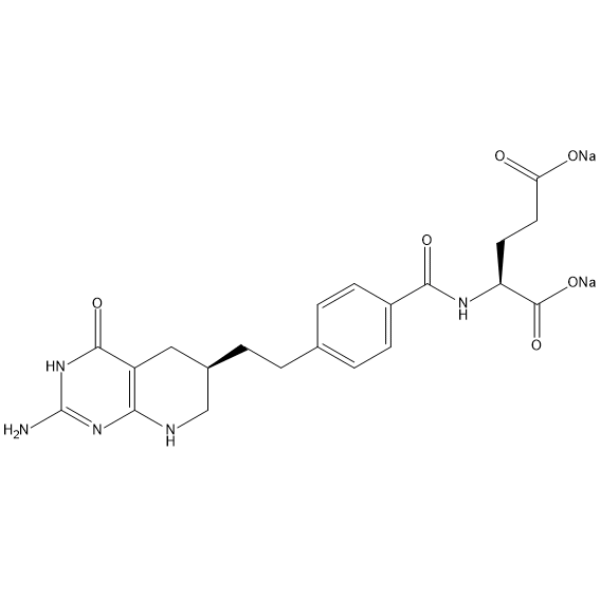Lometrexol disodium (Synonyms: DDATHF disodium) |
| Catalog No.GC66387 |
El lometexol (DDATHF) disÓdico, un antifolato antipurÍnico, puede inhibir la actividad de la glicinamida ribonucleÓtido formiltransferasa (GARFT), pero no induce niveles detectables de roturas de cadenas de ADN. El lometexol disÓdico puede inhibir aÚn mÁs la sÍntesis de purinas de novo, lo que provoca una proliferaciÓn celular anormal y apoptosis, incluso la detenciÓn del ciclo celular. Lometrexol disÓdico tiene actividad anticancerÍgena. El lometrexol disÓdico también es un potente inhibidor de la serina hidroximetiltransferasa humana 1/2 (hSHMT1/2).
Products are for research use only. Not for human use. We do not sell to patients.

Cas No.: 120408-07-3
Sample solution is provided at 25 µL, 10mM.
Lometrexol (DDATHF) disodium, an antipurine antifolate, can inhibit the activity of glycinamide ribonucleotide formyltransferase (GARFT) but do not induce detectable levels of DNA strand breaks. Lometrexol disodium can further inhibit de novo purine synthesis, causing abnormal cell proliferation and apoptosis, even cell cycle arrest. Lometrexol disodium has anticancer activity. Lometrexol disodium also is a potent human Serine hydroxymethyltransferase1/2 (hSHMT1/2) inhibitor[1][2][3].
Lometrexol (DDATHF) disodium binds tightly to GART, resulting in a rapid and prolonged depletion of intracellular purine ribonucleotides[3].
Lometrexol (1-30 μM; 2-10 hours) disodium induces rapid and complete growth inhibition in L1210 cells[3].
Lometrexol (1 μM; 2-24 hours) disodium induces cell cycle arrest in murine leukemia L1210 cells[3].
Cell Viability Assay[3]
| Cell Line: | Mouse leukemia L1210 cells |
| Concentration: | 1, 30 μM |
| Incubation Time: | 2, 4, 6, 8, 10 hours |
| Result: | Induced rapid and complete growth inhibition. |
Cell Cycle Analysis[3]
| Cell Line: | L1210 cells |
| Concentration: | 1 μM |
| Incubation Time: | 2, 4, 8, 12, 24 hours |
| Result: | Caused a rapid loss of the G2/M phase population of cells and an early S phase accumulation of cells by 8 hours. By 24 h, the S phase population appeared to be slowly shifting to higher DNA content, and hence, from mid-to-late S phase. |
Lometrexol (DDATHF; i.p.; 15-60 mg/kg; on gestation day 7.5) disodium induces neural tube defects (NTDs) by disturbing purine metabolism and increases the rate of embryonic resorption and growth retardation in a dose-dependent manner[1].
Lometrexol (i.p.; 40 mg/kg; on gestation day 7.5) disodium decreases glycinamide ribonucleotide formyl transferase (GARFT) activity and Changes of ATP, GTP, dATP and dGTP levels[1].
Lometrexol (i.p.; 40 mg/kg; on gestation day 7.5) disodium induces abnormal proliferation and apoptosis exist in neural tube defects (NTDs)[1].
| Animal Model: | C57BL/6 mice (7-8 week, 18-20 g)[1] |
| Dosage: | 15, 30, 35, 40, 45 and 60 mg/kg |
| Administration: | Intraperitoneal injection; on gestation day 7.5 |
| Result: | Increased the rate of embryonic resorption and growth retardation in a dose-dependent manner. |
| Animal Model: | C57BL/6 mice (7-8 week, 18-20 g)[1] |
| Dosage: | 40 mg/kg |
| Administration: | Intraperitoneal injection; on gestation day 7.5, for 0, 6, 24, 48 and 96 hours |
| Result: | Inhibited glycinamide ribonucleotide formyl transferase (GARFT) activity and GARFT activity was maximally inhibited after at 6 hours. Decreased the levels of ATP, GTP, dATP, and dGTP of NTDs embryonic brain tissue significantly at 6 hours. |
| Animal Model: | C57BL/6 mice (7-8 week, 18-20 g)[1] |
| Dosage: | 40 mg/kg |
| Administration: | Intraperitoneal injection; on gestation day 7.5, for 4 days |
| Result: | Decreased the expression of proliferation-related genes (Pcna, Foxg1 and Ptch1) and increased the expression of apoptosis-related genes (Bax, Casp8 and Casp9) in NTD groups. |
Average Rating: 5 (Based on Reviews and 30 reference(s) in Google Scholar.)
GLPBIO products are for RESEARCH USE ONLY. Please make sure your review or question is research based.
Required fields are marked with *




















